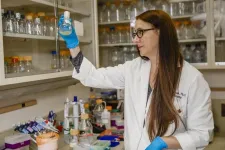(Press-News.org) High-dose pressurized oxygen can stress out old immune cells, leaving behind a younger, better functioning immune system. It helped with acute COVID, and now Anders Kjellberg is testing the method for post-covid as well.
Hyperbaric oxygen therapy, giving patients 100 percent oxygen at a pressure corresponding to 10-20 meters below sea level, has been around for almost 100 years. But the method lacks modern evidence from clinical studies, which also means that there is a lack of knowledge about dosage, all patients receive the same dose.
"When I started my research, I wanted to find out how the treatment should be dosed to different patients," says Anders Kjellberg, deputy chief physician and head of the Hyperbaric Unit at Karolinska University Hospital and researcher who has now written a thesis on hyperbaric oxygen therapy.
But he only had time to do two dose trials - then came the covid-19 pandemic.
"We had patients with oxygen deficiency and uncontrolled inflammation. They had exactly the problems that hyperbaric oxygen therapy can help with," says Anders Kjellberg.
He has tested the treatment on 17 covid-19 patients at three different hospitals and compared it with an equally large control group.
"In the 20 patients we had at Karolinska University Hospital, we saw a huge difference between those who received the treatment and those who did not. They were able to go home much earlier and their vital parameters such as pulse, respiratory rate and oxygenation improved," he says.
The hypothesis is that the treatment exposes the immune cells to a stress that causes old and bad immune cells to die, thereby rejuvenating the entire population of immune cells that function better afterwards.
A study on 80 post-covid patients is now underway, with the hope that they will also benefit from the treatment.
"The results will come later in the year," says Anders Kjellberg.
Publication: On February 16, 2024, Anders Kjellberg defended his doctoral thesis: "Randomised clinical trials with hyperbaric oxygen in COVID-19 and Long COVID : transcriptomic insights into benefits and harms
END
Hyperbaric oxygen therapy tested for post-covid conditions
2024-02-21
ELSE PRESS RELEASES FROM THIS DATE:
Revolutionary breakthrough in solar energy: World’s most efficient QD solar cells developed
2024-02-21
A groundbreaking research breakthrough in solar energy has propelled the development of the world’s most efficient quantum dot (QD) solar cell, marking a significant leap towards the commercialization of next-generation solar cells. This cutting-edge QD solution and device have demonstrated exceptional performance, retaining their efficiency even after long-term storage. Led by Professor Sung-Yeon Jang from the School of Energy and Chemical Engineering at UNIST, a team of researchers has unveiled ...
New water batteries stay cool under pressure
2024-02-21
A global team of researchers and industry collaborators led by RMIT University has invented recyclable ‘water batteries’ that won’t catch fire or explode.
Lithium-ion energy storage dominates the market due to its technological maturity, but its suitability for large-scale grid energy storage is limited by safety concerns with the volatile materials inside.
Lead researcher Distinguished Professor Tianyi Ma said their batteries were at the cutting edge of an emerging field of aqueous energy storage devices, with breakthroughs that significantly improve the technology’s performance and lifespan.
“What ...
Focus on patient experience can improve diabetes care
2024-02-21
WASHINGTON—Health care providers who treat diabetes need to think beyond the clinical numbers, such as solely focusing on a person’s glucose goals. Taking the patient experience into account can improve the quality of care and facilitate attainment of treatment goals, according to a new position statement published in the Endocrine Society’s Journal of Clinical Endocrinology & Metabolism.
The position statement reflects the consensus of two virtual roundtables the Endocrine Society held in 2022. Participants ...
KIER’s success in the development of the world's top-level semi-transparent perovskite solar cells
2024-02-21
The Photovoltaics Research Department of the Korea Institute of Energy Research (hereafter KIER), working with the KIER Energy AI and Computational Science Lab, has achieved advancements in the stability and efficiency of semi-transparent perovskite solar cells. These cells have potential use in building windows and tandem solar cells*. The semi-transparent solar cells achieved a record-breaking efficiency of 21.68%, making them the most efficient amongst the perovskite solar cells using transparent electrodes in the world. Additionally, they showed ...
NIH grant to aid Rumbaugh’s biofilm dispersal research
2024-02-21
Most chronic wound infections share one thing in common: the presence of biofilms, which are composed of many different microorganisms that congregate as a mass, usually on some type of surface such as a wound bed. Biofilms are thought to be associated with up to 80% of infections, and their ability to stick together makes the biofilm and infection exceptionally difficult to kill.
To combat this health care challenge, researchers such as Kendra Rumbaugh, Ph.D., a professor in the Texas Tech University Health Sciences Center (TTUHSC) School of Medicine’s Department of Surgery, are pursuing biofilm dispersal agents such as ...
Study details toxic elements found in stranded whales, dolphins over 15 years
2024-02-21
Whales and dolphins get their nutrients and essential elements through their diet. While eating fish, squid, octopus, crustaceans and other marine mammals, they are also exposed to heavy metal contaminants.
Elevated levels of toxins have been found in stranded dolphins and whales along the Southeastern Coast of the United States. Monitoring toxic contaminants in these stranded marine animals, which serve as important sentinels of environmental contamination, and whose health may be linked to human health, is vital.
Yet, data remain sparse on how specific elements are distributed within an animal’s body, especially for many rarely encountered ...
Inaccurate pulse oximeter readings could limit transplants, heart pumps for Black patients with heart failure
2024-02-21
Racially biased readings of oxygen levels in the blood using pulse oximeters may further limit opportunities for Black patients with heart failure to receive potentially lifesaving treatments, such as heart pumps and transplants, a Michigan Medicine study finds.
“This is especially important because we know that Black patients are already less likely to receive heart pumps or transplants compared to their white counterparts, and these inaccurate readings can further widen a disparity that must be addressed by our health care system,” said first author Scott W. Ketcham, M.D., a third year ...
An awkward family reunion: Sea monsters are our cousins
2024-02-21
KANSAS CITY, MO—February 21, 2024—The sea lamprey, a 500-million-year-old animal with a sharp-toothed suction cup for a mouth, is the thing of nightmares. A new study from the Stowers Institute for Medical Research discovered that the hindbrain—the part of the brain controlling vital functions like blood pressure and heart rate—of both sea lampreys and humans is built using an extraordinarily similar molecular and genetic toolkit.
Research from the lab of Investigator Robb Krumlauf, Ph.D., published on February 20, 2024 in Nature Communications offers a glimpse into how the brains of ancient animals evolved. The team unexpectedly uncovered that ...
Highways through historically redlined areas likely cause air pollution disparities today
2024-02-21
As part of the New Deal, several governmental programs were created to expand homeownership through mortgages and loans. However, neighborhoods with primarily Black or immigrant communities often were rated “hazardous” for repayment under the discriminatory, “redlining” practice that restricted lending. Today, those same areas are exposed to more air pollution than other urban neighborhoods, and according to research published in ACS’ Environmental Science & Technology, the cause could ...
Mercury levels in tuna remain nearly unchanged since 1971, study says
2024-02-21
Tuna is one of the most popular seafoods worldwide. But this protein-rich fish can build up high levels of methylmercury from feeding on contaminated prey, like smaller fish or crustaceans. Despite efforts to reduce mercury emissions into the environment, researchers report in ACS’ Environmental Science & Technology Letters that levels in tuna appear to be unchanged since 1971. They warn that more aggressive emission reduction targets are needed to start nudging down tuna mercury levels.
Environmental ...






